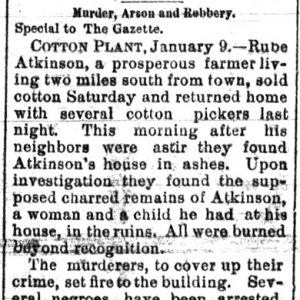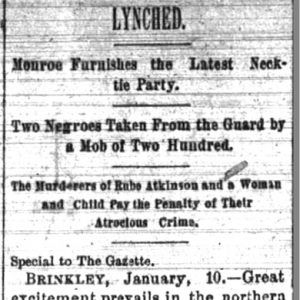calsfoundation@cals.org
Monroe County Lynching of 1893
In January 1893, five men were lynched in Monroe County near Cotton Plant (Woodruff County) for allegedly murdering Reuben Atkinson, his housekeeper, and her child, and then torching Atkinson’s house to cover up the crimes. Census and other public records yield no information on either Atkinson or his alleged murderers.
According to the Arkansas Gazette, on January 7 a “prosperous farmer” named Rube Atkinson went to sell his cotton. He returned to his farm on January 8, and the following morning neighbors awoke to find that Atkinson’s house had burned down. When they went to inspect, they found three bodies in the ruins, which were later identified as those of Atkinson, his housekeeper, and her child. Authorities arrested several African Americans, including Paul Stubbs and Henry Allen. Although the January 10 account in the Gazette indicated that Stubbs had made a partial confession, other reports maintain that Stubbs refused to talk. A later report in the Gazette said that Allen “talked freely,” asserting that Stubbs had shot Atkinson and failed to kill him but had then killed him with an iron poker. Then the two murdered the housekeeper and her child with an axe, stole $600, and set fire to the house. The Gazette opined: “If corroborated, Judge Lynch will likely impanel his jury after the Coroner is through.”
Although the coroner supposedly had enough evidence to try Stubbs and Allen, he held an inquest on January 9 to determine if there were other conspirators. Allen reported that William Hewlett (the New York Sun identifies him as James Hewlett) had taken meat from the burning house, and that Stubbs’s father-in-law, Ed Purcell, had taken the money. Hewlett and Purcell were subsequently put under arrest. According to the Gazette, local African Americans were as enraged as the area’s white citizens: “Many want to take the guilty parties to the spot where the house stood and cremate them, and offer to join in and make it a daylight affair.” Sometime during the night of the inquest, a mob of 200, white and black, overpowered Stubbs’s and Allen’s guards, took the two to the scene of the crime, and hanged them from a tree.
While the Gazette issued no follow-up to these stories, the New York Sun provided additional information. Their report identified the housekeeper as Mrs. Surratt and said that her child was a nine-year-old girl. This may have been the Maggie Surratt who was living and working as a housekeeper in Monroe County in 1880. According to the Sun, Purcell, Hewlett, and a man named Ed Sevier were in custody when, on January 10, authorities “turned [them] loose in the dense forest and cane[brakes] of Cache River bottoms, in order that they might escape the infuriated mob, but they were captured and dealt with…and their bodies secreted in the bottoms.” The Southern Standard of Arkadelphia (Clark County) also reported on these additional deaths, identifying one of these victims as a white man.
For additional information:
“Five Negroes Lynched in Arkansas.” New York Sun, January 14, 1893, p. 2.
“Lynched: Monroe Furnishes the Latest Necktie Party.” Arkansas Gazette, January 11, 1893, p. 2.
“Murder, Arson and Robbery.” Arkansas Gazette, January 10, 1893, p. 2.
“The South.” Southern Standard (Arkadelphia, Arkansas), January 20, 1893, p. 1.
Nancy Snell Griffith
Davidson, North Carolina








Comments
No comments on this entry yet.